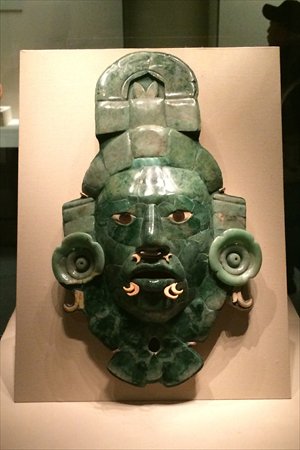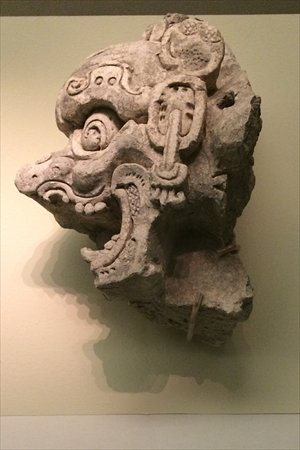HOME >> ARTS
Ancient mystery
By Xiong Yuqing Source:Global Times Published: 2014-11-16 20:53:01
New exhibition peers into the art and culture of Maya civilization

Jade funerary mask from Late Classic period (600-900) Photo: Xiong Yuqing/GT

Effigy of Chaak, the rain god from Late Postclassic (1250-1550) Photo: Xiong Yuqing/GT
"Mysterious," might be the first word that come to most Chinese people's minds when thinking about the ancient Maya, a civilization whose name has been appearing quite frequently in China recently, mostly linked to its amazing astronomy, advanced mathematics and of course doomsday predictions such as those that helped Roland Emmerich's 2012 (2009) earn over 400 million yuan ($65 million) at the Chinese mainland box office.Typing in Maya on China's largest search engine Baidu returns 53 million results - of which 4 million are related to Maya culture, 3.5 million about Maya civilization and 2.8 million about Maya predictions about the end of the world (most of which are fake) - which shows the great curiosity people in China have about this ancient culture that existed on the other side of the world.
A new exhibition, Maya: The Language of Beauty, sets out to satisfy this curiosity. Scheduled to run until March 8, 2015, the ongoing exhibition at the National Museum of China brings 238 artifacts collected from more than 20 museums to the capital. For some of these precious objects, including the 2-ton Stela with a Ruler (600-900), the exhibition marks the first time they have been shown outside of Mexico.
To mark the importance of the exhibition, Chinese President Xi Jinping and Mexican President Enrique Peña Nieto attended the opening ceremony on Thursday. In a speech, Xi took note of the two countries' long history, splendid culture and contributions to the progress of human civilization, while also mentioning how deeply impressed he was by the Chichen Itza ruins during his visit to Mexico last year. During his time on stage, Peña Nieto explained his hope was that the Maya civilization could act as a bridge between the two counties and invited Chinese people visit to Mexico to experience the local culture.
Unusual beauty
Located in what is now Mexico, Guatemala, Honduras and El Salvador, Maya civilization first formed around 10th century BC and reached its peak during the 3rd to 9th centuries AD. Today, the approximately 6 million strong Maya community takes great pride in their 3,000-year-old history and culture.
"We've discovered that Chinese people know a lot about Maya mathematics and astronomy, but less about other aspects of the culture. So we decided to pay more attention to the way the Maya people saw themselves," said Tong Chunyan, the Chinese curator for the exhibition.
The exhibition is divided into four sections: The Body as Canvas, The Clothed Body, The Animal Alter Ego and The Bodies of the Divine. The first two sections delve into the Maya people's aesthetic traditions and views on the human body. Sculptures in this area show this appreciation of the human form by depicting little people and figures afflicted with Ascites disease, a disease that causes people to develop overlarge bellies. The ancient Mayas believed these people had the ability to connect with supernatural.
A special set of exhibitions depict the Maya tradition of "head shaping," a popular practice among the ancient Mayas in which mothers used boards to alter the shape of their newborns' skulls. Along with other visible markings such as painted skin, tattoos and large earlobes, this cranial deformation represent the culture's unique aesthetic preferences.
The third section examines the Mayas' relationship with animals, which they believed were capable of speech and possessed supernatural powers. For instance, as birds that can fly, swim and walk, waterfowl were believed to be supernatural creatures that connected the upper-world, the under-world and the world of man.
"The exhibition focuses on Maya ideas of beauty. Just like other parts of the world, the aesthetics of the Maya people were expressed in many different ways, and finally became a unique form of art," said José Enrique Ortiz Lanz, the manager of museums and exhibitions for the National Institute of Anthropology and History in Mexico.
Cultural coincidence
In 2007, 2005 Galaxy Award (Chinese highest award for science fiction) winner Ma Li (also known as Ma Boyong) published a novel The History of the Conquest of Maya, in which he told the fictional story of Chinese merchants during Shang Dynasty (C.1600-1046 BC) sailing to Mesoamerica and exploring the ancient Maya region. Not only is Ma a fan of Maya culture, some other Chinese authors, such as He Ma, who wrote The Tibet Code series, have also used Maya elements in their works.
Fiction aside, some Chinese scholars, including Wang Guowei and Guo Moruo, have proposed that there might be some connection between ancient China and the Maya empire.
Many similarities can be seen between the two ancient civilizations, for instance their love of jade, which was seen as a sacred and precious stone more valuable than gold.
"Some Maya people wore a jade mask after they died, as they believed jade could aid in the rebirth of life, while some Chinese royals in ancient times wore entire suites made of jade in their coffins," Ortiz Lanz explained. "We selected some of our prettiest jade masks and brought them to this exhibition, so that Chinese visitors would be able to see the essence Maya's ancient jade arts."
Other similarities have to do with the worship of mythical creatures. The Chinese dragon and the Maya Kukulkan were both creatures shaped like a snake, could fly and were associated with prayers for rain.
At the exhibition, visitors can also see imagery where the figurine of Ixchel, the Maya moon goddess, is accompanied by a rabbit, just like the ancient Chinese myth of Chang'e, who flew to the moon after ingesting her husband's potion of immortality.
Ortiz Lanz told the Global Times that currently there is no strong evidence showing that the Maya civilization came from Asia.
"There is also a similar line of thought in Mexican academic circles that some branch of Mexican civilization may have come from Asia, or even China. Some Asian migrant groups may have moved from the Asian continent through the Bering Strait 2,000 years ago, bringing their knowledge and culture with them.
"But all the research in this field is still in a preliminary stage. There are still many objects which might provide evidence that is buried in the sea. We hope that experts from China and Mexico will have more opportunities to cooperate and push this area of study," Ortiz Lanz told the Global Times.
Posted in: Art